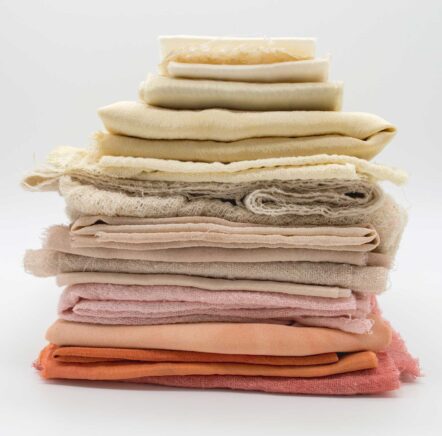The merino wool’s
wear and care


Merino wool has unique qualities. Get to know how the yarn can best unfold its capacities, what you should never do with Merino wool, and how you can best take care of the valuable Merino wool items you bought from Le Picot.
Wear
If you want to profit from all the benefits of merino wool you should avoid layers of synthetic fibers between your merino wool garment and your skin. This would block the transport of humidity. And with that, the magic of cooling in heat and warming in the cold is lost. So, either wear merino wool directly on the skin or with other organic fibers below.
If your skin is susceptible and your merino wool garment still itches, try wearing a layer of merino wool and fibers like cotton, silk, or viscose (Lyocell) below or a mix like our popular Flon T-Shirt.
Finally, do not carry heavy items in your merino wool jerseys’ pockets, as they could wear out. Wool is elastic, especially the fine yarns we use.

With the right care, you can enjoy your merino garments for a long time. | Image: Jason Brisco, Unsplash)
Care
Fortunately, most washing machines these days feature specific wool washing programs. But, care tip number one: merino wool has an autocleaning mechanism. Wash it as infrequently as possible. After wearing, hang your T-shirts, jerseys, or sweaters for a day out in the fresh air, preferably while there is high humidity in the air.
If you need to wash your merino wool garment, always select a wool washing program, and do not wash warmer than 40° C; 30° are preferred. Hand washing is not advisable because temperatures are out of control, and there is too much mechanical impact from the hands on the tissues. Now, as to the detergent, there is an important issue: Standard washing powders, but also some wool detergents contain enzymes that break up protein stains, proteases. As wool contains proteins, these enzymes destroy the structure of the yarn. So always wash with a special wool detergent with no enzymes! Do not use softeners or bleach and never tumble dry. For best result, simply lay the washed garments flat on a bath towel and let dry at room temperature. Another tip: Use a laundry bag to protect your delicate wool garments from damages from zippers or other hard objects. And if your garment has zippers or other hard items, close them.
If your garments are heavily stained, soak them first in water with some wool detergent. If stains remain, rub off small, dry stains. If you are not lucky, try using gall soap. Always test on lesser visible areas first.
One last tip: You’re not the only one who appreciates wool. Moths do too. Prevent moth infestation, preferably with traditional weapons like lavender flowers or cedarwood or then with moth paper or moth powder. If your garments got under attack, clean both your storage and your textiles. Wash the cloths gently and dry them in full light. Moths don’t like sunshine. Alternatively, you can stow away your merino items for a day in the freezer.
Image 1: Aiwok, Wikimedia Commons (https://commons.wikimedia.org/wiki/User:Aiwok) Image 2: Mel Poole, Unsplash (https://unsplash.com/@melipoole)

